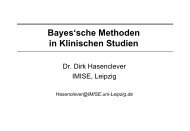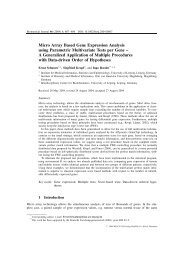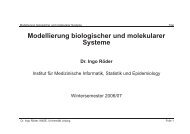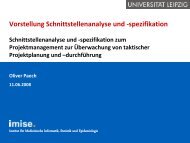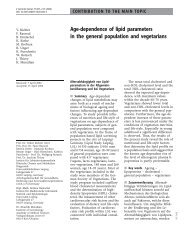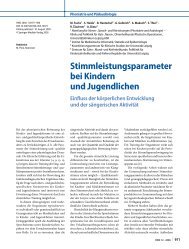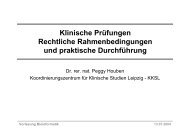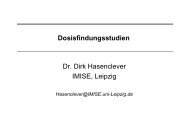Entropy Inference and the James-Stein Estimator, with Application to ...
Entropy Inference and the James-Stein Estimator, with Application to ...
Entropy Inference and the James-Stein Estimator, with Application to ...
You also want an ePaper? Increase the reach of your titles
YUMPU automatically turns print PDFs into web optimized ePapers that Google loves.
ENTROPY INFERENCE AND THE JAMES-STEIN ESTIMATOR<br />
shows that MI can be computed from <strong>the</strong> joint <strong>and</strong> marginal entropies of <strong>the</strong> two genes X <strong>and</strong> Y .<br />
Note that this definition is equivalent <strong>to</strong> <strong>the</strong> one given in Equation 7 which is based on <strong>the</strong> Kullback-<br />
Leibler divergence. From Equation 8 it is also evident that MI(X,Y) is <strong>the</strong> information shared<br />
between <strong>the</strong> two variables.<br />
For gene expression data <strong>the</strong> estimation of MI <strong>and</strong> <strong>the</strong> underlying entropies is challenging due<br />
<strong>to</strong> <strong>the</strong> small sample size, which requires <strong>the</strong> use of a regularized entropy estima<strong>to</strong>r such as <strong>the</strong><br />
shrinkage approach we propose here. Specifically, we proceed as follows:<br />
• As a prerequisite <strong>the</strong> data must be discrete, <strong>with</strong> each measurement assuming one of K levels.<br />
If <strong>the</strong> data are not already discretized, we propose employing <strong>the</strong> simple algorithm of<br />
Freedman <strong>and</strong> Diaconis (1981), considering <strong>the</strong> measurements of all genes simultaneously.<br />
• Next, we estimate <strong>the</strong> p = K 2 cell frequencies of <strong>the</strong> K × K contingency table for each pair X<br />
<strong>and</strong> Y using <strong>the</strong> shrinkage approach (Eqs. 4 <strong>and</strong> 5). Note that typically <strong>the</strong> sample size n is<br />
much smaller than K 2 , thus simple approaches such as ML are not valid.<br />
• Finally, from <strong>the</strong> estimated cell frequencies we calculate H(X), H(Y), H(X,Y) <strong>and</strong> <strong>the</strong> desired<br />
MI(X,Y).<br />
5.3 Mutual Information Network for E. Coli Stress Response Data<br />
MI shrinkage estimates<br />
ARACNE−processed MIs<br />
Frequency<br />
0 200 400 600 800<br />
Frequency<br />
0 1000 2000 3000 4000 5000<br />
0.6 0.8 1.0 1.2 1.4 1.6 1.8<br />
mutual information<br />
0.0 0.5 1.0 1.5<br />
mutual information<br />
Figure 2: Left: Distribution of estimated mutual information values for all 5151 gene pairs of <strong>the</strong><br />
E. coli data set. Right: Mutual information values after applying <strong>the</strong> ARACNE gene<br />
pair selection procedure. Note that <strong>the</strong> most MIs have been set <strong>to</strong> zero by <strong>the</strong> ARACNE<br />
algorithm.<br />
For illustration, we now analyze data from Schmidt-Heck et al. (2004) who conducted an experiment<br />
<strong>to</strong> observe <strong>the</strong> stress response in E. Coli during expression of a recombinant protein. This<br />
1477



